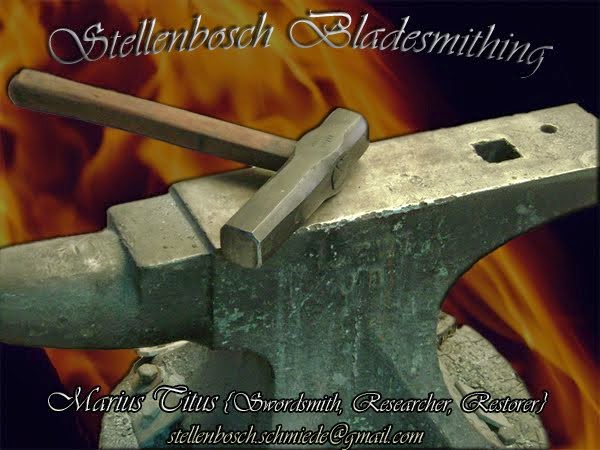Tuesday 1 December 2015
Gladius projects from a few years ago
With swords and mountings from this era I can explore the various possibilities offered by organic hilt material as well as the stark contrast between brightly polished brass and leather.
For the second gladius I used purple heart, giraffe bone and buffalo horn with a few brass spacers to present something a little different from the usual concept while still staying within the realm of realism.
Tuesday 3 November 2015
Work on Walloon sword and a few extra blades
This project is going to be a bit challenging as the hilt needs to have guard plates inserted. In order to do that, I will cut channels into the inside of the loop guards and then cut iron sheet to fit snugly. Once secured, they will be copper brazed for added strength.
I am working on a hanger and rapier blade as well.
Heat treating rapier blades is always a challenge as the long and narrow profile allows the blade to both bend and curve edgewise during a quench and that often means that the entire heat treatment will have to be repeated. The blades are also notoriously eager to snap or crack during the straightening steps that normally follows the heat treatment of large blades.
A small trade secret for those attempting traditionally made complex hilts, shape the elements in such a way that when gripped by locked tongs, the parts to be welded are pressed together under tension. Before fluxing, use the first heat to press out any remaining gaps, reheat to welding heat and add flux while in the forge and then squeeze the parts together with the appropriate tongs and then take it out to gently hammer the join. At the starting phase the steel will move with a slightly squishy feel under the hammer and as soon as the steel starts resisting, the weld is solid.
Sunday 4 October 2015
Making Pole-arms
I have recently completed a few pole-arms. It has been quite a good exercise in forge-welding as the heads consisted of various components that had to be joined.
The heads are EN45 and tool steel with mild steel sockets and other components. I used ash for the hafts, treated with a linseed oil and pine resin based mixture.
Sunday 6 September 2015
Sword with blackened fittings
This two-handed sword features darkened guard, pommel and pommel-nut. In order to darken the fittings to a suitably dark tone to contrast with the brass elements, I used a thermal method.
The steel fittings were polished and cleaned thoroughly before being buried in a bed of coals and ash. The ash layer helps keep unwanted oxygen away from the metal as it heats up. For obvious reasons, no air is worked through the forge. As soon as the piece reaches a dark cherry red colour (judged in a dark room), it is briskly removed from the ash bed and all ash shaken of. A soft dry brush helps remove the odd patches of clinging ash.
After a few second of exposure to air, the piece is quenched in oil. Overheating or taking too long before quenching will lead to a layer that is too thick and flaky.
This method is only one of many used to blue or darken steel fittings.
Tuesday 1 September 2015
Horse and gourd themed tsuba
Inspired by a series of recent unexpected events, I decided to work on this project. It refers to the sennin Chokwaro summoning a horse from his gourd and the expression 'as unexpected as a horse from a gourd.'
The pictures follow the project through the various stages.
The clay mixture used during the rust inducing process consists of finely ground red ochre and anthracite.
The clay mixture used during the rust inducing process consists of finely ground red ochre and anthracite.
Subscribe to:
Posts (Atom)






















































